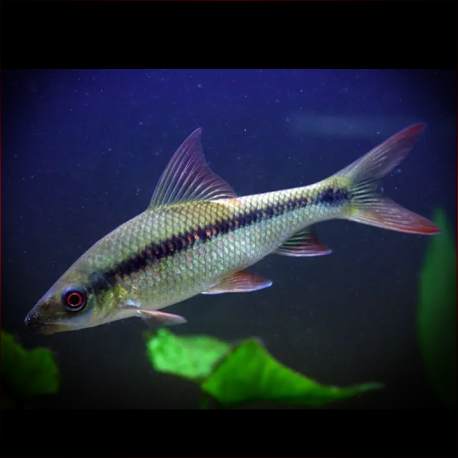More info
Datasheet
| Maximum Size | 20.0cm / 7.87inches |
General Description
Labeo Angra is a species belonging to the family Cyprinidae and is distinguished by its coloration featuring a brownish dorsal surface, yellow flanks and abdomen, and a black to bluish lateral stripe that runs from the eye to the caudal-fin base. The genus Labeo, to which this species belongs, is a diverse group comprising over 100 species spread across Africa and Asia. Recent phylogenetic studies have divided this genus into four subtribes, with Labeo falling under the Labeoina group alongside other closely related species.
Aquarium Setup
For a successful aquarium setup for Labeo Angra, it is essential to recreate its natural benthic habitat. Provide ample space for swimming as well as hiding spots such as rocks and caves where these fish can retreat. A tank size of at least 30 gallons is recommended, with a sandy substrate to mimic their riverbed environment. Ensure efficient filtration and maintain the water temperature between 73°F and 79°F (23°C - 26°C).
Behaviour
Garras crossocheilus tanichthys is primarily a benthic species, displaying behaviors characteristic of bottom-dwelling fish. They are known to undertake annual spawning migrations within their native river systems, showcasing a particular migratory behavior during the breeding season.
Feeding and Diet
In their natural habitat, Garras crossocheilus tanichthys are omnivorous, feeding on algae, small invertebrates, and organic detritus. In a captive setting, their diet should be varied and include high-quality flake or pellet food supplemented with fresh vegetables such as blanched zucchini and spinach. Offering occasional live or frozen foods like bloodworms or brine shrimp can help simulate their natural feeding behavior.
Reproduction & Dimorphism
The breeding behavior of Garras crossocheilus tanichthys is characterized by spawning migrations within their native river systems. During the breeding season, males may exhibit more vibrant colors and develop small breeding tubercles on their heads and pectoral fins. Females may appear rounder when carrying eggs, showing a slight distension of the abdominal area.
Habitat and Distribution
Garras crossocheilus tanichthys has a wide distribution range encompassing areas in Pakistan, Nepal, northern India, Bangladesh, and Myanmar. They are commonly found in river systems like the Brahmaputra River in India, where they undertake their annual spawning migrations. The species prefers benthic habitats within these river systems, where they can forage for food and seek shelter.

